Evaluating of Four Irrigation Depths on Soil Moisture and Temperature, and Seed Cotton Yield Under Film-Mulched Drip Irrigation in Northwest China
Abstract
1. Introduction
2. Materials and Methods
2.1. Experiment Site Description
2.2. Experimental Design
2.3. Sampling and Measurement
2.3.1. Weather Data
2.3.2. Leaf Area Index and Seed Cotton Yield
2.3.3. Irrigation Water Use Efficiency
2.3.4. Measurement of Soil Temperature
2.3.5. Measurement of Soil Moisture
2.3.6. Variability of Soil Moisture
2.4. Structural Equation Model
2.5. Statistical Analysis
3. Results
3.1. Air Temperature and Radiation
3.2. Leaf Area Index, Seed Cotton Yield, and Irrigation Water Use Efficiency
3.3. Soil Temperature
3.3.1. Temporal Variation in Soil Temperature
3.3.2. Daily Variation in Soil Temperature
3.3.3. The Effects of Various Irrigation Depths on Soil Temperature at Different Growth Stages
3.4. Soil Moisture
3.4.1. Distribution of Soil Moisture
3.4.2. Soil Water Storage
3.4.3. SMC Characteristics at Different Growth Stages Under Various Irrigation Depths
3.4.4. Variability Characteristics of SMC at Different Growth Stages Under Various Irrigation Depths
3.5. The Correlation Between Seed Cotton Yield and Soil Environment
4. Discussion
4.1. The Influence of Irrigation Depth on LAI, Seed Cotton Yield, and Irrigation Water Use Efficiency
4.2. Effects of Irrigation Depth on Soil Temperature in Cotton Field Under Film-Mulched Drip Irrigation
4.3. Effects of Irrigation Depth on Soil Moisture in Cotton Field Under Film-Mulched Drip Irrigation
4.4. The Spatial Variability of Soil Moisture Under Various Irrigation Depths in Cotton Field Under Film-Mulched Drip Irrigation
4.5. The Relationship Between Soil Moisture and Temperature and Seed Cotton Yield
5. Conclusions
Author Contributions
Funding
Data Availability Statement
Conflicts of Interest
References
- Himanshu, S.K.; Ale, S.; Bordovsky, J.; Darapuneni, M. Evaluation of crop-growth-stage-based deficit irrigation strategies for cotton production in the Southern High Plains. Agric. Water Manag. 2019, 225, 105728. [Google Scholar] [CrossRef]
- National Bureau of Statistics of China. China Statistical Yearbook; China Statistics Press: Beijing, China, 2022. Available online: http://www.stats.gov.cn/ (accessed on 5 July 2025).
- Tan, S.; Wang, Q.J.; Xu, D.; Zhang, J.H.; Shan, Y.Y. Evaluating effects of four controlling methods in bare strips on soil temperature, water and salt accumulation under film-mulched drip irrigation. Field Crops Res. 2017, 214, 350–358. [Google Scholar] [CrossRef]
- Guo, Y.; Shen, Y.J. Agricultural water supply/demand changes under projected future climate change in the arid region of northwestern China. J. Hydrol. 2016, 540, 257–273. [Google Scholar] [CrossRef]
- Wang, H.D.; Li, J.; Cheng, M.H.; Zhang, F.C.; Wang, X.K.; Fan, J.L.; Wu, L.F.; Fang, D.P.; Zou, H.Y.; Xiang, Y.Z. Optimal drip fertigation management improves yield, quality, water and nitrogen use efficiency of greenhouse cucumber. Sci. Hortic. 2019, 243, 357–366. [Google Scholar] [CrossRef]
- Si, Z.Y.; Zain, M.; Mehmood, F.; Wang, G.S.; Gao, Y.; Duan, A.W. Effects of nitrogen application rate and irrigation regime on growth, yield, and water-nitrogen use efficiency of drip-irrigated winter wheat in the North China Plain. Agric. Water Manag. 2020, 231, 106002. [Google Scholar] [CrossRef]
- Tuerxun, M.; Youliwasi, F.; Tuohuti, A. Impact factors of excessive household fertilization: A case study of cotton growing in Xinjiang, China. J. Cotton Sci. 2016, 28, 619–627, (In Chinese with English Abstract). [Google Scholar]
- Wang, Z.; Fan, B.; Guo, L. Soil salinization after long-term mulched drip irrigation poses a potential risk to agricultural sustainability. Eur. J. Soil Sci. 2019, 70, 20–24. [Google Scholar] [CrossRef]
- Chai, Q.; Gan, Y.; Zhao, C.; Xu, H.L.; Waskon, R.M.; Niu, Y.; Siddique, K.H.M. Regulated deficit irrigation for crop production under drought stress. A review. Agron. Sustain. Dev. 2016, 36, 3. [Google Scholar] [CrossRef]
- Greaves, G.E.; Wang, Y.M. Identifying irrigation strategies for improved agricultural water productivity in irrigated maize production through crop simulation modelling. Sustainability 2017, 9, 630. [Google Scholar] [CrossRef]
- Du, T.S.; Kang, S.Z.; Zhang, J.H.; Davies, W.J. Deficit irrigation and sustainable water resource strategies in agriculture for China’s food security. J. Exp. Bot. 2015, 66, 2253–2269. [Google Scholar] [CrossRef]
- Cheng, M.H.; Wang, H.D.; Fan, J.L.; Zhang, S.H.; Wang, Y.L.; Li, Y.P.; Sun, X.; Yang, L.; Zhang, F.C. Water productivity and seed cotton yield in response to deficit irrigation: A global meta-analysis. Agric. Water Manag. 2021, 255, 107027. [Google Scholar] [CrossRef]
- Liu, H.; Gao, Y.; Sun, J.; Wu, X.; Li, Y. Responses of yield, water use efficiency and quality of short-season cotton to irrigation management: Interactive effects of irrigation methods and deficit irrigation. Irrig. Sci. 2017, 35, 125–139. [Google Scholar] [CrossRef]
- Papastylianou, P.T.; Argyrokastritis, I.G. Effect of limited drip irrigation regime on yield, yield components, and fiber quality of cotton under Mediterranean conditions. Agric. Water Manag. 2014, 142, 127–134. [Google Scholar] [CrossRef]
- Zhang, D.M.; Luo, Z.; Liu, S.H.; Li, W.J.; Tang, W.; Dong, H.Z. Effects of deficit irrigation and plant density on growth, yield and fiber quality. Field Crops Res. 2024, 197, 1–9. [Google Scholar] [CrossRef]
- Liao, H.; Liu, H.Y.; Tian, Q.Y.; Zhou, B.H.; Yang, H.L.; Hou, Z.A. Deficit drip irrigation combined with nitrogen application improves cotton yield and nitrogen use efficiency by promoting plant 15N uptake and remobilization. Field Crops Res. 2025, 324, 109792. [Google Scholar] [CrossRef]
- Arriaga, J.; Rubio, F.R. A distributed parameters model for soil water content: Spatial and temporal variability analysis. Agric. Water Manag. 2017, 183, 101–106. [Google Scholar] [CrossRef]
- Li, X.Y.; Šimůnek, J.; Shi, H.B.; Yan, J.W.; Peng, Z.Y.; Gong, X.W. Spatial distribution of soil water, soil temperature, and plant roots in a drip-irrigated intercropping field with plastic mulch. Eur. J. Agron. 2017, 83, 47–56. [Google Scholar] [CrossRef]
- Malamy, J.E. Intrinsic and environmental response pathways that regulate root system architecture. Plant Cell Environ. 2005, 28, 67–77. [Google Scholar] [CrossRef]
- Bogena, H.R.; Herbst, M.; Huisman, J.A.; Rosenbaum, U.; Weuthen, A.; Vereecken, H. Potential of wireless sensor networks for measuring soil water content variability. Vadose Zone J. 2010, 9, 1002–1013. [Google Scholar] [CrossRef]
- Bittelli, M.; Ventura, F.; Campbell, G.S.; Snyder, R.L.; Gallegati, F.; Pisa, P.R. Coupling of heat, water vapor, and liquid water fluxes to compute evaporation in bare soils. J. Hydrol. 2008, 3, 191–205. [Google Scholar] [CrossRef]
- Boyd, N.; van Acker, R. The effects of depth and fluctuating soil moisture on the emergence of eight annual and six perennial plant species. Weed Sci. 2003, 51, 725–730. [Google Scholar] [CrossRef]
- Abouziena, H.F.; Radwan, S.M. Allelopathic effects of sawdust, rice straw, burclover weed and cogongrass on weed control and development of onion. Int. J. ChemTech Res. 2015, 7, 337–345. [Google Scholar] [CrossRef]
- Zribi, W.; Aragü’es, R.; Medina, E.; Faci, J.M. Efficiency of inorganic and organic mulching materials for soil evaporation control. Soil Tillage Res. 2015, 148, 40–45. [Google Scholar] [CrossRef]
- Zhao, Y.; Mao, X.M.; Duan, M. Effects of film mulching and irrigation amount on farmland water–heat dynamics and growth of seed–maize. Trans. CSAM 2018, 49, 275–284, (In Chinese with English Abstract). [Google Scholar]
- Li, R.; Hou, X.Q.; Jia, Z.K.; Han, Q.F.; Ren, X.L.; Yang, B.P. Effects on soil temperature, moisture, and maize yield of cultivation with ridge and furrow mulching in the rainfed area of the Loess Plateau, China. Agric. Water Manag. 2013, 116, 101–109. [Google Scholar] [CrossRef]
- Yang, J.; Mao, X.M.; Wang, K.; Yang, W.C. The coupled impact of plastic film mulching and deficit irrigation on soil water/heat transfer and water use efficiency of spring wheat in Northwest China. Agric. Water Manag. 2018, 201, 232–245. [Google Scholar] [CrossRef]
- Fan, Y.Q.; Ding, R.S.; Kang, S.Z.; Hao, X.M.; Du, T.S.; Tong, L.; Li, S.E. Plastic mulch decreases available energy and evapotranspiration and improves yield and water use efficiency in an irrigated maize cropland. Agric. Water Manag. 2016, 179, 122–131. [Google Scholar] [CrossRef]
- Fry, J.E.; Guber, A.K. Temporal stability of field-scale patterns in soil water content across topographically diverse agricultural landscapes. J. Hydrol. 2020, 580, 124260. [Google Scholar] [CrossRef]
- Brocca, L.; Zucco, G.; Mittelbach, H.; Moramarco, T.; Seneviratne, S.I. Absolute versus temporal anomaly and percent of saturation soil moisture spatial variability for six networks worldwide. Water Resour. Res. 2014, 50, 5560–5576. [Google Scholar] [CrossRef]
- Mittelbach, H.; Seneviratne, S.I. A new perspective on the spatio-temporal variability of soil moisture: Temporal dynamics versus time invariant contributions. Hydrol. Earth Syst. Sci. Discuss. 2012, 16, 2169–2179. [Google Scholar] [CrossRef]
- Özerdem, M.S.; Acar, E.; Ekinci, R. Soil moisture estimation over vegetated Agricultural Areas: Tigris Basin, Turkey from Radarsat-2 data by polarimetric decomposition models and a generalized regression neural network. Remote Sens. 2017, 9, 395. [Google Scholar] [CrossRef]
- Rossato, L.; Alvalá, R.C.; Marengo, J.A.; Zeri, M.; Cunha, A.P.M.; Pires, L.B.M.; Barbosa, H.A. Impact of soil moisture on crop yields over Brazilian Semiarid. Front. Environ. Sci. 2017, 5, 73. [Google Scholar] [CrossRef]
- Yetbarek, E.; Ojha, R. Spatio-temporal variability of soil moisture in a cropped agricultural plot within the Ganga Basin, India. Agric. Water Manag. 2020, 234, 106108. [Google Scholar] [CrossRef]
- Allen, R.G.; Pereira, L.S.; Raes, D.; Smith, M. Crop Evapotranspiration: Guidelines for Computing Crop Water Requirements; FAO: Rome, Italy, 1998. [Google Scholar]
- Qiao, F. Plant Physiology Experimental Analysis and Determination Technology; China Agricultural Science and Technology Press: Beijing, China, 2002. [Google Scholar]
- Watson, D.J. Comparative physiological studies in the growth of field crops. I: Variation in net assimilation rate and leaf area between species and varieties, and within and between years. Ann. Bot. 1947, 11, 41–76. [Google Scholar] [CrossRef]
- Zhang, W.T.; Wu, H.Q.; Gu, H.B.; Feng, G.L.; Wang, Z.; Sheng, J.D. Variability of soil salinity at multiple spatio-temporal scales and the related driving factors in the Oasis areas of Xinjiang, China. Pedosphere 2014, 6, 753–762. [Google Scholar] [CrossRef]
- Zhang, R.D. Theory and Application of Spatial Variation; Science Press: Beijing, China, 2005. [Google Scholar]
- Junior, V.V.; Carvalho, M.P.; Dafonte, J.; Freddi, O.S.; Vazquez, E.V.; Ingaramo, O.E. Spatial variability of soil water content and mechanical resistance of Brazilian ferralsol. Soil Tillage Res. 2006, 85, 166–177. [Google Scholar] [CrossRef]
- Ferrero, A.; Usowicz, B.; Lipiec, J. Effects of tractor traffic on spatial variability of soil strength and water content in grass covered and cultivated sloping vineyard. Soil Tillage Res. 2005, 84, 127–138. [Google Scholar] [CrossRef]
- Yao, R.J.; Yang, J.S.; Liu, G.M. Spatial variability of soil salinity and moisture and their estimations by CoKriging method—A case study in characteristic field of Yellow River delta. J. Soil Water Conserv. 2006, 20, 133–138, (In Chinese with English Abstract). [Google Scholar]
- Gama-Rodrigues, A.C.; Sales, M.V.S.; Silva, P.S.D.; Comerford, W.P.; Cropper, W.P.; Gama-Rodrigues, E.F. An exploratory analysis of phosphorus transformations in tropical soils using structural equation modeling. Biogeochemistry 2014, 118, 453–469. [Google Scholar] [CrossRef]
- DeTar, W.R. Yield and growth characteristics for cotton under various irrigation regimes on sandy soil. Agric. Water Manag. 2008, 95, 69–76. [Google Scholar] [CrossRef]
- Ünlü, M.; Kanber, R.; Koç, D.L.; Tekin, S.; Kapur, B. Effects of deficit irrigation on the yield and yield components of drip irrigated cotton in a mediterranean environment. Agric. Water Manag. 2011, 98, 597–605. [Google Scholar] [CrossRef]
- Singh, Y.; Rao, S.S.; Regar, P.L. Deficit irrigation and nitrogen effects on seed cotton yield, water productivity and yield response factor in shallow soils of semi-arid environment. Agric. Water Manag. 2010, 97, 965–970. [Google Scholar] [CrossRef]
- Kang, Y.; Wang, R.; Wan, S.; Hu, W.; Jiang, S.; Liu, S. Effects of different water levels on cotton growth and water use through drip irrigation in an arid region with saline ground water of Northwest China. Agric. Water Manag. 2012, 109, 117–126. [Google Scholar] [CrossRef]
- Basal, H.; Dagdelen, N.; Unay, A. Effects of deficit drip irrigation ratios on cotton (Gossypium hirsutum L.) yield and fibre quality. J. Agron. Crop Sci. 2010, 195, 19–29. [Google Scholar] [CrossRef]
- Leogrande, R.; Vitti, C.; Lopedota, O.; Ventrella, D.; Montemurro, F. Effects of irrigation volume and saline water on maize yield and soil in Southern Italy. Irrig. Drain. 2016, 65, 243–253. [Google Scholar] [CrossRef]
- Liao, Y.; Cao, H.X.; Xue, W.K.; Liu, X. Effects of the combination of mulching and deficit irrigation on the soil water and heat, growth and productivity of apples. Agric. Water Manag. 2021, 243, 106482. [Google Scholar] [CrossRef]
- Zhou, L.M.; Zhang, F.; Liu, C.A. Improved yield by harvesting water with ridges and subgrooves using buried and surface plastic mulchs in a semiarid area of China. Soil Till. Res. 2015, 150, 21–29. [Google Scholar] [CrossRef]
- Zhang, G.; Liu, C.; Xiao, C.; Xie, R.; Ming, B.; Hou, P.; Liu, G.; Xu, W.; Shen, D.; Wang, K.; et al. Optimizing water use efficiency and economic return of superhigh yield spring maize under drip irrigation and plastic mulching in arid areas of China. Field Crops Res. 2017, 211, 137–146. [Google Scholar] [CrossRef]
- Al-Ogaidi, A.A.M.; Wayayok, A.; Rowshon, M.K.; Abdullah, A.F. Wetting patterns estimation under drip irrigation systems using an enhanced empirical model. Agric. Water Manag. 2016, 176, 203–213. [Google Scholar] [CrossRef]
- Bajpai, A.; Kaushal, A. Soil moisture distribution under trickle irrigation: A review. Water Supply 2020, 20, 761–772. [Google Scholar] [CrossRef]
- Machado, R.M.A.; Oliveira, M.R.G. Tomato root distribution, yield and fruit quality under different subsurface drip irrigation regimes and depths. Irrig. Sci. 2003, 24, 15–24. [Google Scholar] [CrossRef]
- Ren, D.Y.; Xu, X.; Hao, Y.Y.; Huang, G.H. Modeling and assessing field irrigation water use in a canal system of Hetao, upper Yellow River basin: Application to maize, sunflower and watermelon. J. Hydrol. 2016, 532, 122–139. [Google Scholar] [CrossRef]
- Liao, R.K.; Wu, W.Y.; Hu, Y.Q.; Xu, D.; Huang, Q.N.; Wang, S.Y. Micro-irrigation strategies to improve water-use efficiency of cherry trees in Northern China. Agric. Water Manag. 2019, 221, 388–396. [Google Scholar] [CrossRef]
- Suo, G.D.; Xie, Y.S.; Zhang, Y.; Luo, H. Long-term effects of different surface mulching techniques on soil water and fruit yield in an apple orchard on the Loess Plateau of China. Sci. Hortic. 2019, 246, 643–651. [Google Scholar] [CrossRef]
- Huang, J.H.; Liao, Y.C.; Gao, M.S.; Yin, R.J. Effects of tillage and mulching on orchard soil moisture content and temperature in Loess Plateau. Chin. J. Appl. Ecol. 2009, 20, 2652–2658, (In Chinese with English Abstract). [Google Scholar]
- Martinez-Fernández, J.; Ceballos, A. Temporal stability of soil moisture in a large-field experiment in Spain. Soil Sci. Soc. Am. J. 2003, 67, 1647–1656. [Google Scholar] [CrossRef]
- Famiglietti, J.; Devereaux, J.A.; Laymon, C.A.; Tsegaye, T.; Houser, P.R.; Jackson, T.J.; Graham, S.T.; Rodell, M.; Oevelen, V. Ground-based investigation of soil moisture variability within remote sensing footprints during the Southern Great Plains 1997 (SGP97) hydrology experiment. Water Resour. Res. 1999, 35, 1839–1852. [Google Scholar] [CrossRef]
- Brocca, L.; Melone, F.; Moramarco, T.; Morbidelli, R. Spatial-temporal variability of soil moisture and its estimation across scales. Water Resour. Res. 2010, 46, W02516. [Google Scholar] [CrossRef]
- Brocca, L.; Tullo, T.; Melone, F.; Moramarco, T.; Morbidelli, R. Catchment scale soil moisture spatial–temporal variability. J. Hydrol. 2012, 422–423, 63–75. [Google Scholar] [CrossRef]
- Rosenbaum, U.; Bogena, H.R.; Herbst, M.; Huisman, J.A.; Peterson, T.J.; Weuthen, A.; Western, A.W.; Vereecken, H. Seasonal and event dynamics of spatial soil moisture patterns at the small catchment scale. Water Resour. Res. 2012, 48, W10544. [Google Scholar] [CrossRef]
- Tuure, J.; Räsänen, M.; Hautala, M.; Pellikka, P.; Mäkelä, P.S.A.; Alakukku, L. Plant residue mulch increases measured and modelled soil moisture content in the effective root zone of maize in semi-arid Kenya. Soil Tillage Res. 2021, 209, 104945. [Google Scholar] [CrossRef]
- Mubvumba, P.; DeLaune, P.B.; Hons, F.M. Soil water dynamics under a warm-season cover crop mixture in continuous wheat. Soil Tillage Res. 2021, 206, 104823. [Google Scholar] [CrossRef]
- Nyawade, S.O.; Karanja, N.N.; Gachene, C.K.K.; Schulte-Geldermann, E.; Parker, K. Effect of potato hilling on soil temperature, soil moisture distribution and sediment yield on a sloping terrain. Soil Tillage Res. 2018, 184, 24–36. [Google Scholar] [CrossRef]
- Sampathkumar, T.; Pandian, B.J.; Mahimairaja, S. Soil moisture distribution and root characters as influenced by deficit irrigation through drip system in cotton–maize cropping sequence. Agric. Water Manag. 2012, 103, 43–53. [Google Scholar] [CrossRef]
- Hou, X.H.; Fan, J.L.; Zhang, F.C.; Hu, W.H.; Yan, F.L.; Xiao, C.; Li, Y.P.; Cheng, H.L. Determining water use and crop coefficients of drip-irrigated cotton in south Xinjiang of China under various irrigation amounts. Ind. Crops Prod. 2022, 176, 114376. [Google Scholar] [CrossRef]
- Chen, C.Q.; Lei, C.X.; Deng, A.X.; Qian, C.R.; Hoogmoed, W.; Zhang, W.J. Will higher minimum temperatures increase corn production in Northeast China? An analysis of historical data over 1965–2008. Agric. For. Meteorol. 2011, 151, 1580–1588. [Google Scholar] [CrossRef]
- Song, B.; Stöcklin, J.; Gao, Y.Q.; Zhang, Z.Q.; Yang, Y.; Li, Z.M.; Sun, H. Habitat-specific responses of seed germination and seedling establishment to soil water condition in two Rheum species in the high Sino-Himalayas. Ecol. Res. 2013, 28, 643–651. [Google Scholar] [CrossRef]
- Zhang, L.H.; Xu, C.; Yan, W.P.; Sun, N.; Tan, G.B.; Yu, J.; Zhao, H.X.; Li, F.; Meng, X.M.; Bian, S.F. Effects of surface mulching on soil water and temperature efficiency and maize yield in semi-arid area. Agric. Res. Arid Areas 2023, 41, 179–192, (In Chinese with English Abstract). [Google Scholar]
- Salau, A.W.; Olasantan, F.O.; Bodunde, J.G.; Makinde, E.A. Soil temperature and moisture content changes with growth and yield of cassava/vegetable intercrops. Arch. Agron. Soil Sci. 2014, 64, 447–460. [Google Scholar] [CrossRef]
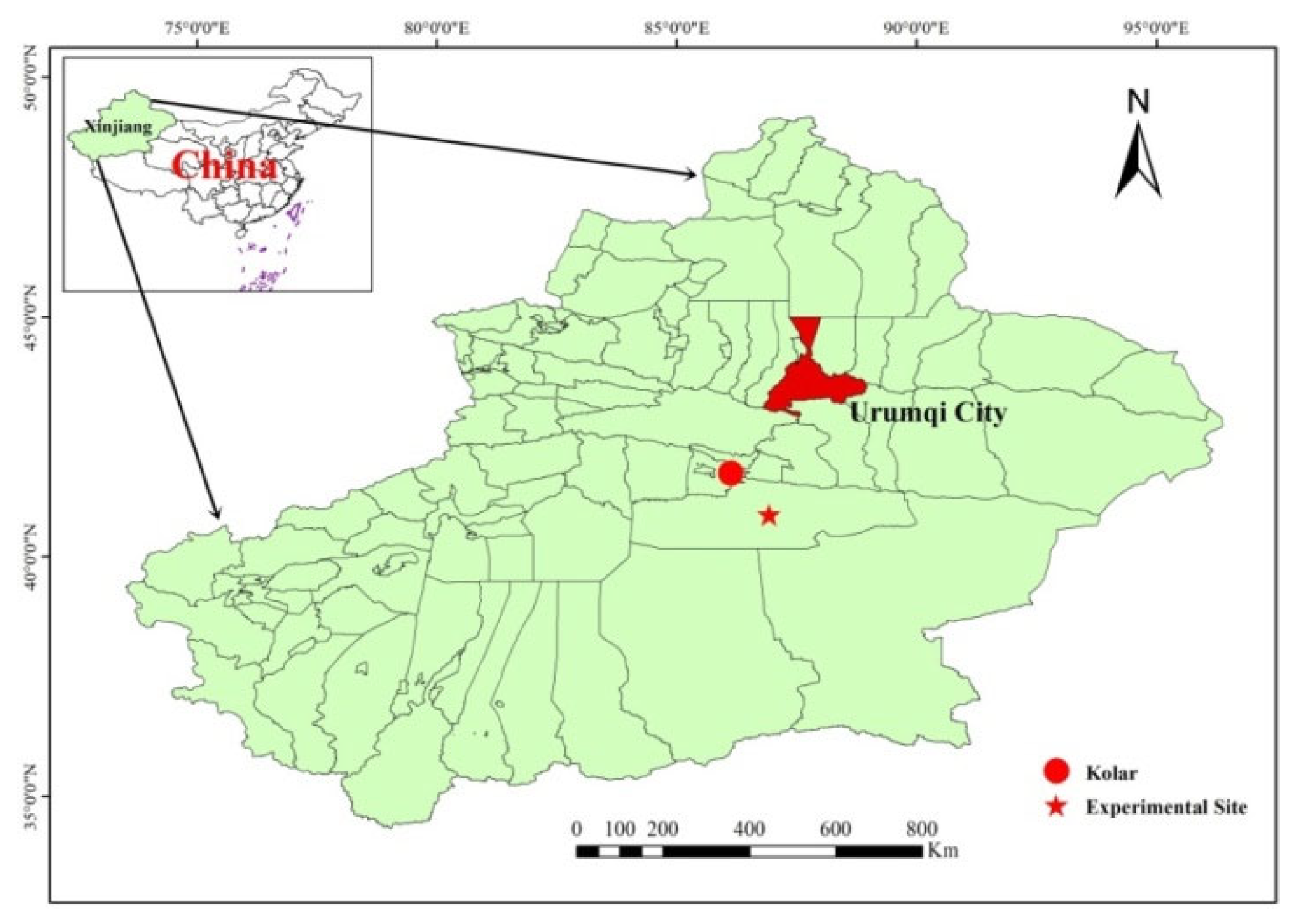

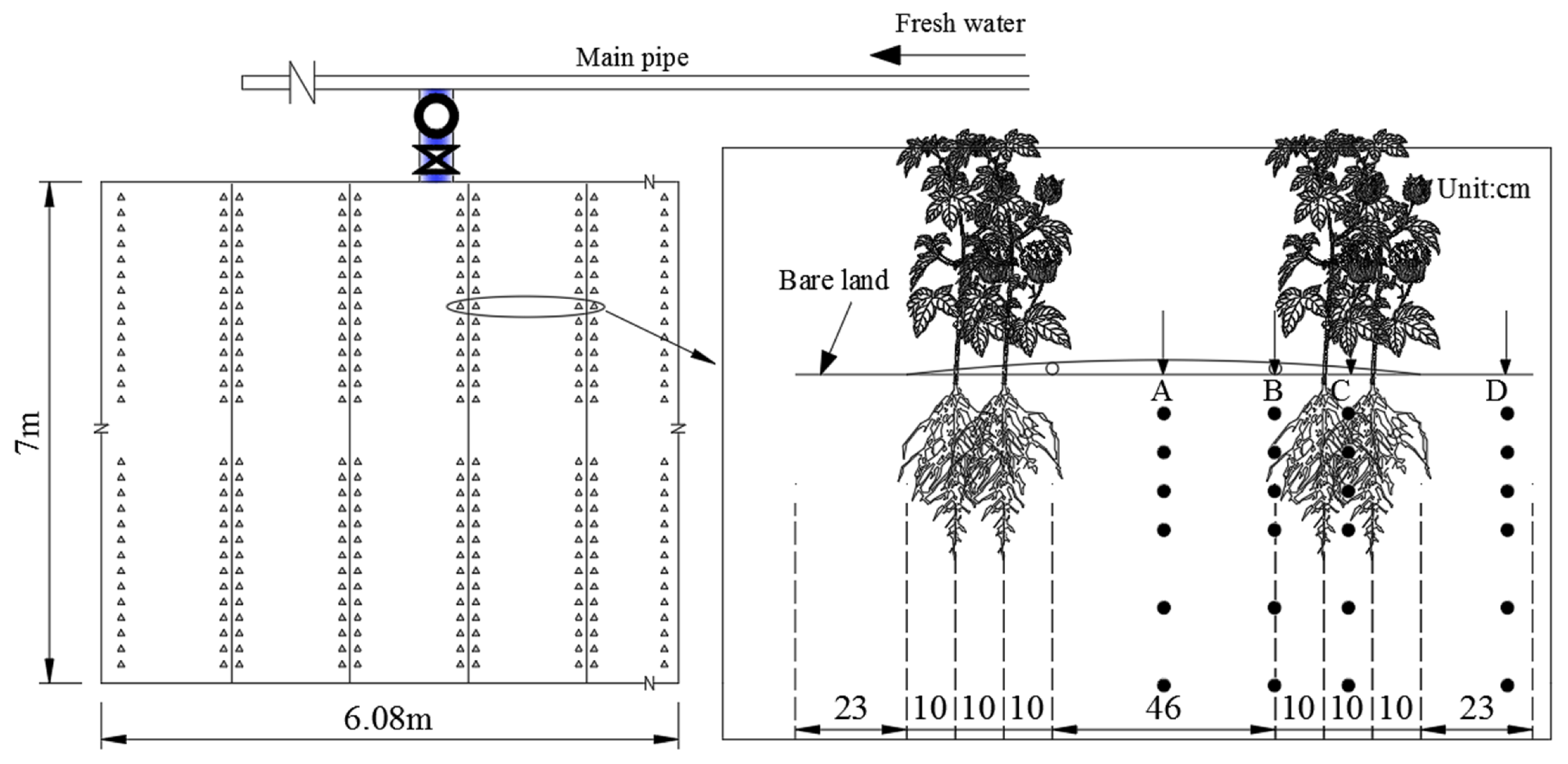

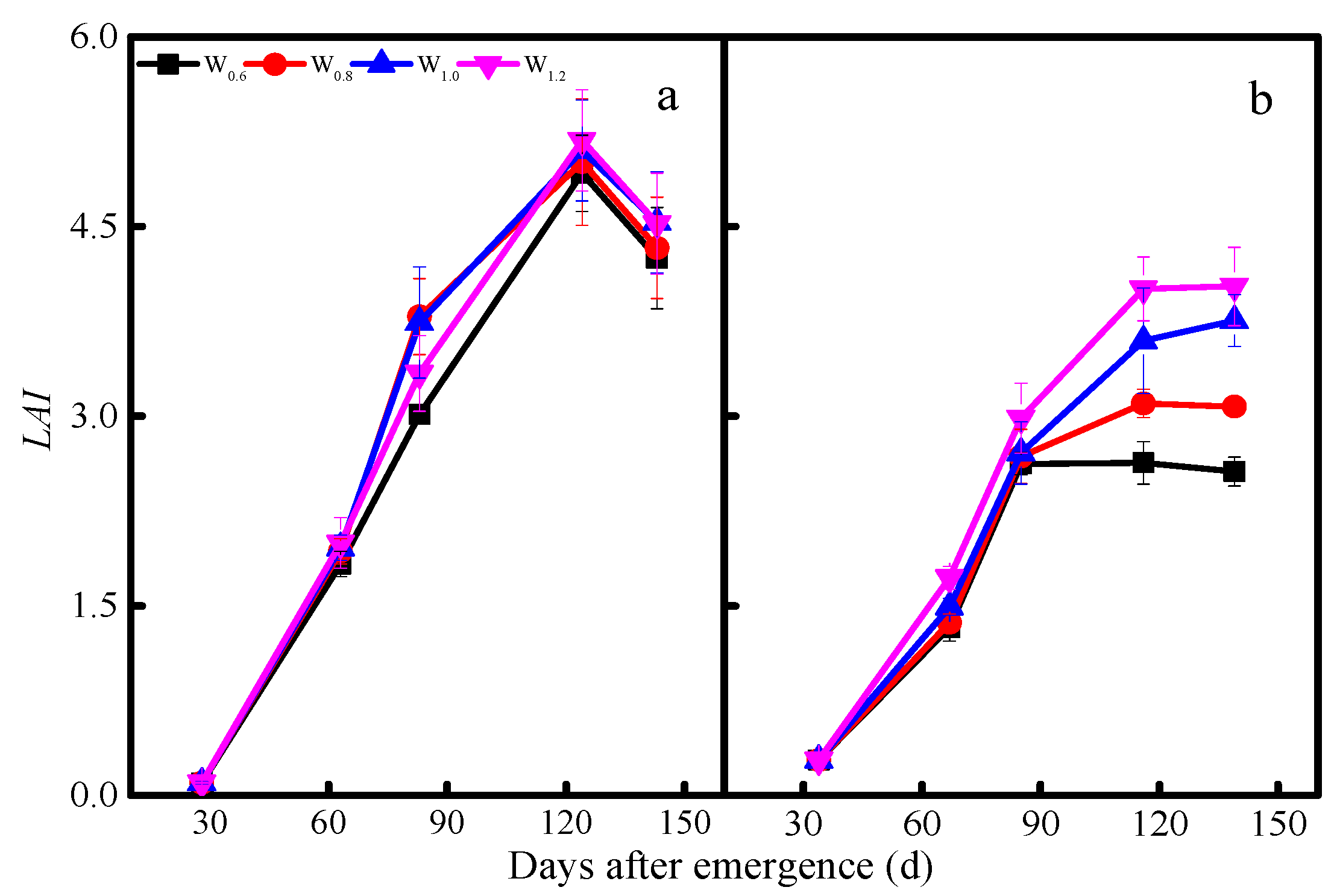
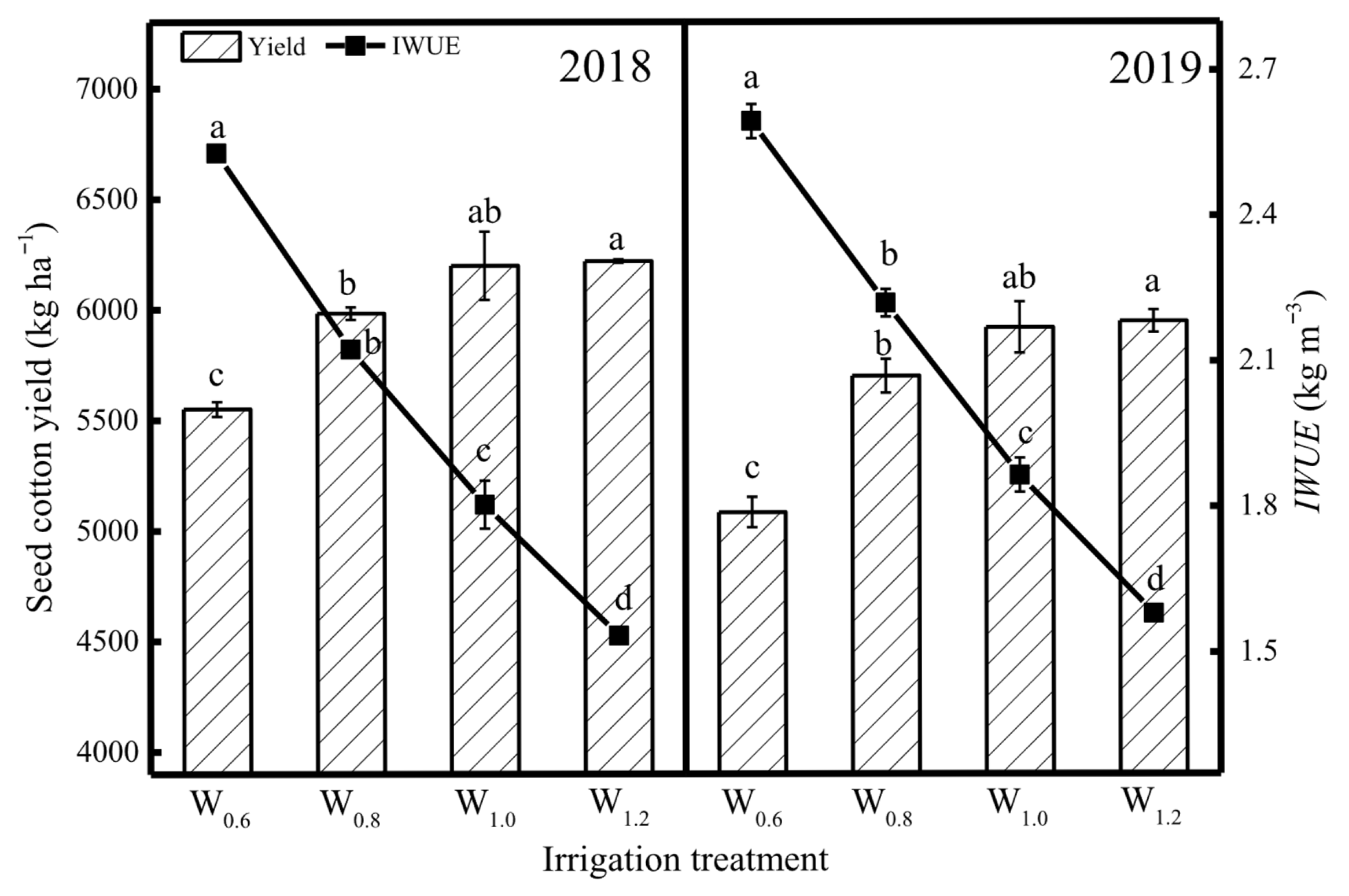




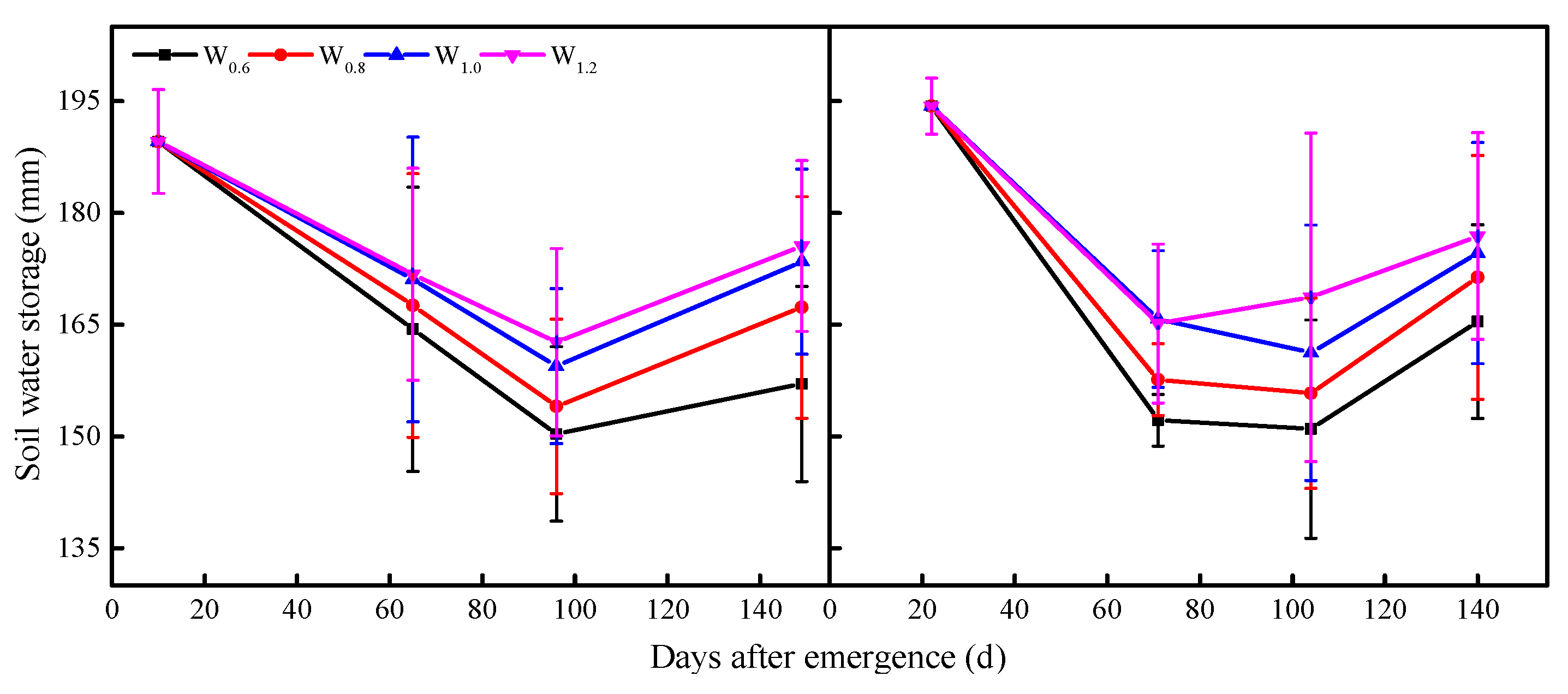
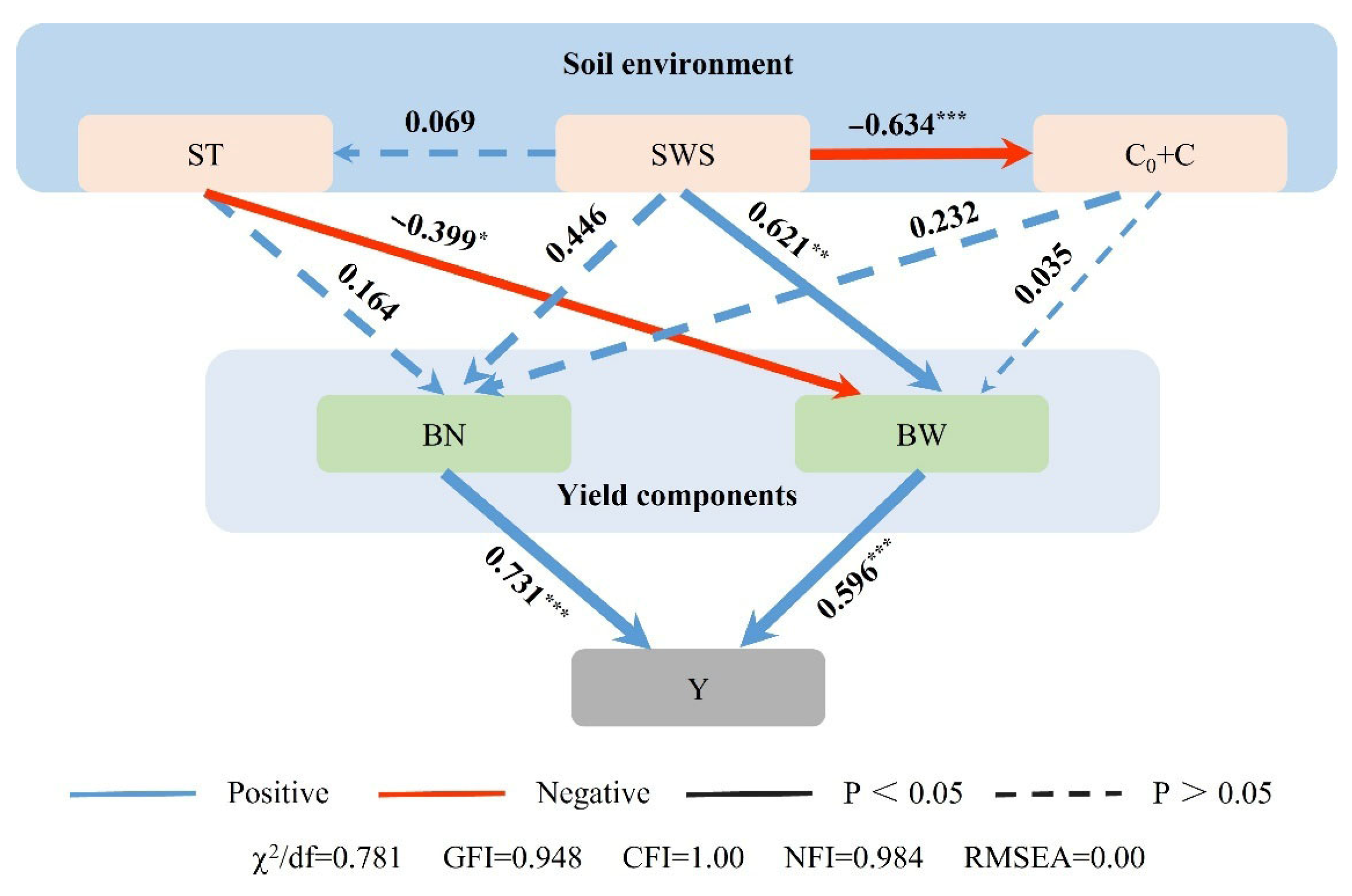
| Depth (cm) | Soil Texture | Soil Mechanical Composition (%) | Bulk Density (g cm−3) | Field Capacity (%) | ||
|---|---|---|---|---|---|---|
| Clay | Silt | Sand | ||||
| 0~10 | Sandy loam | 2.00 | 43.54 | 54.46 | 1.58 | 20.67 |
| 10~20 | Silt loam | 3.30 | 49.30 | 47.41 | 1.60 | 22.82 |
| 20~30 | Silt loam | 2.28 | 54.03 | 43.69 | 1.59 | 16.14 |
| 30~40 | Silt loam | 3.37 | 48.23 | 48.40 | 1.56 | 17.46 |
| 40~60 | Sandy loam | 3.12 | 44.79 | 52.09 | 1.63 | 20.08 |
| 60~80 | Sandy | 0.00 | 10.16 | 89.84 | 1.64 | 12.20 |
| Stages | Soil Depth (cm) | 2018 | 2019 | ||||||||||||||
|---|---|---|---|---|---|---|---|---|---|---|---|---|---|---|---|---|---|
| SMC (%) | SMC (%) | ||||||||||||||||
| W0.6 | W0.8 | W1.0 | W1.2 | W0.6 | W0.8 | W1.0 | W1.2 | ||||||||||
| # | CV | # | CV | # | CV | # | CV | # | CV | # | CV | # | CV | # | CV | ||
| B | 0~10 | 0.121 | 0.198 | 0.129 | 0.190 | 0.137 | 0.219 | 0.140 | 0.189 | 0.114 | 0.175 | 0.113 | 0.139 | 0.120 | 0.173 | 0.125 | 0.173 |
| 10~20 | 0.122 | 0.186 | 0.127 | 0.128 | 0.140 | 0.159 | 0.143 | 0.135 | 0.104 | 0.091 | 0.112 | 0.134 | 0.127 | 0.155 | 0.122 | 0.188 | |
| 20~30 | 0.139 | 0.208 | 0.143 | 0.208 | 0.146 | 0.207 | 0.141 | 0.187 | 0.124 | 0.053 | 0.127 | 0.134 | 0.143 | 0.127 | 0.147 | 0.150 | |
| 30~40 | 0.171 | 0.129 | 0.174 | 0.166 | 0.175 | 0.213 | 0.180 | 0.207 | 0.156 | 0.052 | 0.167 | 0.030 | 0.173 | 0.027 | 0.174 | 0.073 | |
| 40~60 | 0.236 | 0.069 | 0.236 | 0.055 | 0.235 | 0.027 | 0.234 | 0.019 | 0.225 | 0.014 | 0.232 | 0.025 | 0.235 | 0.017 | 0.231 | 0.023 | |
| F&BS | 0~10 | 0.110 | 0.135 | 0.117 | 0.166 | 0.126 | 0.150 | 0.124 | 0.159 | 0.116 | 0.087 | 0.119 | 0.100 | 0.125 | 0.117 | 0.134 | 0.152 |
| 10~20 | 0.107 | 0.120 | 0.113 | 0.145 | 0.113 | 0.081 | 0.122 | 0.112 | 0.108 | 0.107 | 0.118 | 0.136 | 0.116 | 0.127 | 0.132 | 0.217 | |
| 20~30 | 0.121 | 0.153 | 0.121 | 0.089 | 0.128 | 0.192 | 0.142 | 0.217 | 0.118 | 0.226 | 0.121 | 0.301 | 0.129 | 0.229 | 0.146 | 0.216 | |
| 30~40 | 0.149 | 0.166 | 0.153 | 0.178 | 0.162 | 0.164 | 0.169 | 0.159 | 0.150 | 0.159 | 0.163 | 0.168 | 0.167 | 0.184 | 0.177 | 0.219 | |
| 40~60 | 0.225 | 0.076 | 0.228 | 0.095 | 0.233 | 0.070 | 0.229 | 0.068 | 0.224 | 0.077 | 0.225 | 0.072 | 0.234 | 0.079 | 0.231 | 0.089 | |
| BO | 0~10 | 0.103 | 0.131 | 0.113 | 0.052 | 0.119 | 0.074 | 0.120 | 0.055 | 0.118 | 0.087 | 0.125 | 0.127 | 0.131 | 0.101 | 0.126 | 0.123 |
| 10~20 | 0.117 | 0.054 | 0.127 | 0.149 | 0.132 | 0.096 | 0.131 | 0.127 | 0.130 | 0.206 | 0.140 | 0.152 | 0.144 | 0.129 | 0.146 | 0.166 | |
| 20~30 | 0.145 | 0.043 | 0.159 | 0.187 | 0.161 | 0.164 | 0.160 | 0.148 | 0.146 | 0.101 | 0.151 | 0.177 | 0.161 | 0.163 | 0.166 | 0.073 | |
| 30~40 | 0.174 | 0.146 | 0.182 | 0.148 | 0.194 | 0.127 | 0.208 | 0.125 | 0.171 | 0.137 | 0.179 | 0.143 | 0.182 | 0.124 | 0.195 | 0.121 | |
| 40~60 | 0.220 | 0.087 | 0.232 | 0.045 | 0.238 | 0.026 | 0.239 | 0.029 | 0.233 | 0.031 | 0.237 | 0.042 | 0.236 | 0.043 | 0.236 | 0.038 | |
| Year | Stages | Location | SMC (%) | |||||||||||
|---|---|---|---|---|---|---|---|---|---|---|---|---|---|---|
| W0.6 | W0.8 | W1.0 | W1.2 | |||||||||||
| 0–20 | 20–40 | SR | 0–20 | 20–40 | SR | 0–20 | 20–40 | SR | 0–20 | 20–40 | SR | |||
| 2018 | B | A | 0.140 | 0.187 | 1.334 | 0.143 | 0.194 | 1.357 | 0.157 | 0.202 | 1.284 | 0.149 | 0.201 | 1.351 |
| B | 0.132 | 0.147 | 1.109 | 0.134 | 0.157 | 1.167 | 0.161 | 0.219 | 1.359 | 0.159 | 0.155 | 0.975 | ||
| C | 0.124 | 0.156 | 1.252 | 0.134 | 0.157 | 1.166 | 0.149 | 0.166 | 1.111 | 0.150 | 0.156 | 1.043 | ||
| D | 0.089 | 0.130 | 1.460 | 0.101 | 0.126 | 1.257 | 0.121 | 0.170 | 1.405 | 0.109 | 0.130 | 1.199 | ||
| F&BS | A | 0.110 | 0.161 | 1.462 | 0.120 | 0.154 | 1.276 | 0.119 | 0.170 | 1.432 | 0.121 | 0.192 | 1.582 | |
| B | 0.121 | 0.126 | 1.040 | 0.120 | 0.130 | 1.084 | 0.131 | 0.140 | 1.067 | 0.129 | 0.136 | 1.060 | ||
| C | 0.113 | 0.114 | 1.008 | 0.128 | 0.117 | 0.915 | 0.119 | 0.154 | 1.300 | 0.140 | 0.146 | 1.048 | ||
| D | 0.090 | 0.139 | 1.544 | 0.092 | 0.147 | 1.606 | 0.123 | 0.175 | 1.423 | 0.102 | 0.149 | 1.461 | ||
| BO | A | 0.102 | 0.160 | 1.566 | 0.115 | 0.159 | 1.389 | 0.121 | 0.174 | 1.431 | 0.123 | 0.179 | 1.452 | |
| B | 0.120 | 0.173 | 1.444 | 0.134 | 0.200 | 1.496 | 0.139 | 0.205 | 1.482 | 0.140 | 0.197 | 1.404 | ||
| C | 0.116 | 0.166 | 1.433 | 0.126 | 0.184 | 1.463 | 0.129 | 0.186 | 1.446 | 0.124 | 0.208 | 1.672 | ||
| D | 0.102 | 0.138 | 1.355 | 0.106 | 0.137 | 1.293 | 0.114 | 0.145 | 1.271 | 0.114 | 0.152 | 1.338 | ||
| 2019 | B | A | 0.112 | 0.138 | 1.237 | 0.121 | 0.154 | 1.271 | 0.139 | 0.170 | 1.219 | 0.138 | 0.187 | 1.350 |
| B | 0.115 | 0.141 | 1.221 | 0.115 | 0.151 | 1.318 | 0.127 | 0.150 | 1.182 | 0.134 | 0.154 | 1.147 | ||
| C | 0.120 | 0.141 | 1.177 | 0.123 | 0.140 | 1.131 | 0.131 | 0.162 | 1.231 | 0.130 | 0.154 | 1.187 | ||
| D | 0.090 | 0.140 | 1.557 | 0.092 | 0.144 | 1.562 | 0.096 | 0.151 | 1.581 | 0.092 | 0.148 | 1.617 | ||
| F&BS | A | 0.123 | 0.171 | 1.386 | 0.134 | 0.190 | 1.418 | 0.134 | 0.192 | 1.438 | 0.160 | 0.209 | 1.307 | |
| B | 0.106 | 0.125 | 1.184 | 0.112 | 0.126 | 1.120 | 0.125 | 0.128 | 1.026 | 0.142 | 0.142 | 1.001 | ||
| C | 0.117 | 0.118 | 1.006 | 0.123 | 0.125 | 1.010 | 0.117 | 0.132 | 1.126 | 0.127 | 0.158 | 1.243 | ||
| D | 0.103 | 0.123 | 1.199 | 0.100 | 0.130 | 1.244 | 0.106 | 0.140 | 1.317 | 0.104 | 0.137 | 1.322 | ||
| BO | A | 0.132 | 0.173 | 1.312 | 0.150 | 0.188 | 1.250 | 0.153 | 0.194 | 1.268 | 0.160 | 0.201 | 1.257 | |
| B | 0.145 | 0.173 | 1.187 | 0.145 | 0.178 | 1.230 | 0.142 | 0.185 | 1.302 | 0.140 | 0.184 | 1.316 | ||
| C | 0.116 | 0.154 | 1.331 | 0.124 | 0.163 | 1.317 | 0.139 | 0.169 | 1.221 | 0.128 | 0.175 | 1.361 | ||
| D | 0.104 | 0.135 | 1.297 | 0.113 | 0.131 | 1.164 | 0.116 | 0.138 | 1.194 | 0.116 | 0.160 | 1.381 | ||
| Stages | Irrigation Depth | 2018 | 2019 | ||||||||||
|---|---|---|---|---|---|---|---|---|---|---|---|---|---|
| Model | C0 | C0 + C | C0/(C0 + C) | A | R2 | Model | C0 | C0 + C | C0/(C0 + C) | A | R2 | ||
| B | W0.6 | Gaussian | 0.100 | 41.200 | 0.002 | 72.434 | 0.893 | Gaussian | 0.100 | 41.200 | 0.002 | 74.166 | 0.854 |
| W0.8 | Gaussian | 0.100 | 41.200 | 0.002 | 77.146 | 0.902 | Gaussian | 0.100 | 41.200 | 0.002 | 71.274 | 0.868 | |
| W1.0 | Gaussian | 0.010 | 31.010 | 0.000 | 68.122 | 0.909 | Gaussian | 0.010 | 31.010 | 0.000 | 65.004 | 0.842 | |
| W1.2 | Gaussian | 0.010 | 31.010 | 0.000 | 69.802 | 0.937 | Gaussian | 0.010 | 31.010 | 0.000 | 67.490 | 0.849 | |
| F&BS | W0.6 | Gaussian | 0.100 | 41.200 | 0.002 | 70.443 | 0.893 | Gaussian | 0.100 | 41.200 | 0.002 | 70.010 | 0.913 |
| W0.8 | Gaussian | 0.100 | 41.200 | 0.002 | 70.148 | 0.920 | Gaussian | 0.100 | 41.200 | 0.002 | 70.443 | 0.961 | |
| W1.0 | Gaussian | 0.100 | 41.200 | 0.002 | 68.399 | 0.880 | Gaussian | 0.100 | 41.200 | 0.002 | 65.212 | 0.906 | |
| W1.2 | Gaussian | 0.010 | 31.010 | 0.000 | 63.081 | 0.904 | Gaussian | 0.010 | 31.010 | 0.000 | 62.458 | 0.921 | |
| BO | W0.6 | Gaussian | 0.100 | 41.200 | 0.002 | 76.747 | 0.914 | Gaussian | 0.040 | 31.070 | 0.001 | 68.035 | 0.827 |
| W0.8 | Gaussian | 0.800 | 32.590 | 0.025 | 64.346 | 0.900 | Gaussian | 0.010 | 31.010 | 0.000 | 69.230 | 0.881 | |
| W1.0 | Gaussian | 0.700 | 32.390 | 0.022 | 62.960 | 0.886 | Gaussian | 0.010 | 31.010 | 0.000 | 78.462 | 0.904 | |
| W1.2 | Gaussian | 1.100 | 43.200 | 0.025 | 69.455 | 0.925 | Gaussian | 0.010 | 31.010 | 0.000 | 73.647 | 0.926 | |
| Index | Yield | I1 | I2 | I3 | I4 | T1 | T2 | T3 | T4 | SMC1 | SMC2 | SMC3 | SMC4 |
|---|---|---|---|---|---|---|---|---|---|---|---|---|---|
| Yield | 1.00 | ||||||||||||
| I1 | 0.47 | 1.00 | |||||||||||
| I2 | 0.79 ** | −0.02 | 1.00 | ||||||||||
| I3 | 0.84 ** | 0.09 | 0.99 *** | 1.00 | |||||||||
| I4 | 0.73 * | −0.14 | 0.99 *** | 0.97 *** | 1.00 | ||||||||
| T1 | −0.08 | 0.73 * | −0.26 | −0.18 | −0.35 | 1.00 | |||||||
| T2 | −0.10 | 0.83 ** | −0.50 | −0.41 | −0.61 | 0.87 ** | 1.00 | ||||||
| T3 | −0.65 * | 0.24 | −0.74 * | −0.70 * | −0.77 * | 0.57 | 0.70 * | 1.00 | |||||
| T4 | 0.12 | 0.92 *** | −0.28 | −0.18 | −0.40 | 0.88 ** | 0.97 *** | 0.59 | 1.00 | ||||
| SMC1 | −0.47 | −1.00 *** | 0.02 | −0.09 | 0.14 | −0.73 * | −0.83 ** | −0.24 | −0.92 *** | 1.00 | |||
| SMC2 | 0.92 *** | 0.69 * | 0.65 * | 0.71 * | 0.56 | 0.23 | 0.19 | −0.44 | 0.39 | −0.69 * | 1.00 | ||
| SMC3 | 0.66 * | −0.22 | 0.96 *** | 0.93 *** | 0.99 *** | −0.40 | −0.66 * | −0.78 * | −0.47 | 0.22 | 0.50 | 1.00 | |
| SMC4 | 0.64 * | −0.30 | 0.90 ** | 0.87 ** | 0.92 *** | −0.57 | −0.70 * | −0.68 * | −0.51 | 0.30 | 0.37 | 0.88 ** | 1.00 |
Disclaimer/Publisher’s Note: The statements, opinions and data contained in all publications are solely those of the individual author(s) and contributor(s) and not of MDPI and/or the editor(s). MDPI and/or the editor(s) disclaim responsibility for any injury to people or property resulting from any ideas, methods, instructions or products referred to in the content. |
© 2025 by the authors. Licensee MDPI, Basel, Switzerland. This article is an open access article distributed under the terms and conditions of the Creative Commons Attribution (CC BY) license (https://creativecommons.org/licenses/by/4.0/).
Share and Cite
Hou, X.; Hu, W.; Li, Q.; Fan, J.; Zhang, F. Evaluating of Four Irrigation Depths on Soil Moisture and Temperature, and Seed Cotton Yield Under Film-Mulched Drip Irrigation in Northwest China. Agronomy 2025, 15, 1674. https://doi.org/10.3390/agronomy15071674
Hou X, Hu W, Li Q, Fan J, Zhang F. Evaluating of Four Irrigation Depths on Soil Moisture and Temperature, and Seed Cotton Yield Under Film-Mulched Drip Irrigation in Northwest China. Agronomy. 2025; 15(7):1674. https://doi.org/10.3390/agronomy15071674
Chicago/Turabian StyleHou, Xianghao, Wenhui Hu, Quanqi Li, Junliang Fan, and Fucang Zhang. 2025. "Evaluating of Four Irrigation Depths on Soil Moisture and Temperature, and Seed Cotton Yield Under Film-Mulched Drip Irrigation in Northwest China" Agronomy 15, no. 7: 1674. https://doi.org/10.3390/agronomy15071674
APA StyleHou, X., Hu, W., Li, Q., Fan, J., & Zhang, F. (2025). Evaluating of Four Irrigation Depths on Soil Moisture and Temperature, and Seed Cotton Yield Under Film-Mulched Drip Irrigation in Northwest China. Agronomy, 15(7), 1674. https://doi.org/10.3390/agronomy15071674








